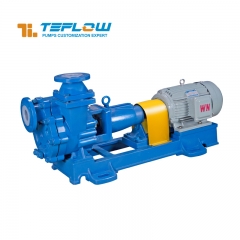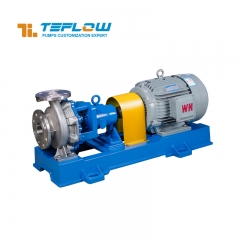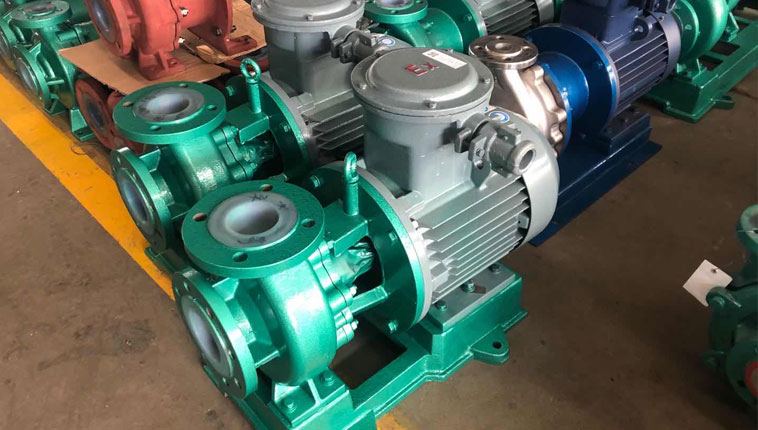In fluid transportation in the chemical, pharmaceutical, environmental protection and other industries, magnetic pumps are widely used due to their advantages of no leakage and high safety. However, motor overload is a common failure, which can cause equipment shutdown and motor burnout, affecting production and causing losses. Therefore, it is crucial to deeply analyze the common causes of overload and develop effective coping strategies.
Magnetic pump motor overload means that the actual load power of the motor exceeds the rated power, resulting in an abnormal increase in current. Overload often causes increased heating, reduced speed, and increased noise. If not addressed promptly, this can lead to insulation aging, winding burnout, and even electrical fires.
Common causes of magnetic pump motor overload
一、Motor's own factors
1.Improper model selection: The load power is not calculated according to the working conditions, the rated power of the motor is less than the actual demand, or the speed and voltage do not match the pump body. For example, when conveying high-viscosity fluids, using a low-viscosity motor can easily cause overload due to excessive resistance.
2.Internal failure: Winding short circuit reduces impedance and causes current to surge; winding grounding changes operating parameters; bearing wear increases rotational resistance, exceeding the motor's load capacity and causing overload.
二、Magnetic coupling failure
As a core transmission component, the demagnetization of permanent magnets will weaken the magnetic field and reduce torque, and the motor needs to increase current to maintain operation; foreign objects entering between the inner and outer magnetic rotors will destroy the transmission relationship, increase resistance, and cause a sudden increase in load.
三、Pump and piping system problems
1.Abnormal parts in the pump: Long-term wear of the impeller, bearings, etc. causes the fitting clearance to increase, or there is jamming or blockage (such as the entry of impurities), which will hinder the rotation of the motor and cause the current to increase.
2.Piping system problems: Pipelines with small diameter, excessive length, many elbows, or blockage (scaling, valve damage) will increase fluid resistance, increase pump head and power consumption; sudden full opening of the outlet valve will cause a sudden increase in flow and a surge in load.
四、Improper use and operation
1.Irregular starting: Starting with the outlet valve fully open, or starting frequently, will cause the motor to be subjected to inrush current, accelerate insulation aging and cause overload.
2.Working conditions deviate from the design: The viscosity and density of the actual conveying fluid are much higher than the design value, or the flow rate exceeds the rated value for a long time, which will increase the pump shaft power and cause the motor to overload.
Strategies for dealing with magnetic pump motor overload
一、Optimize motor selection and maintenance
1.Scientific selection: Calculate the load power according to the working conditions and select a motor with matching parameters. When conveying high-viscosity and high-density fluids, appropriately increase the rated power and give priority to high-quality brands.
2.Regular maintenance: Check winding insulation and DC resistance, and deal with short circuits and grounding faults in a timely manner; check bearing lubrication and replace them in time if worn; clean the motor surface to ensure heat dissipation.
二、Strengthen magnetic coupling management
Regularly check whether the permanent magnets are demagnetized and whether their appearance is intact. Replace them promptly if demagnetized; clean foreign objects between the rotors. If any abnormal noise or vibration occurs during operation, stop the machine immediately for inspection.
三、Optimize pump body and pipeline
1.Pump body maintenance: Check internal parts regularly and replace them when they are severely worn; clean out impurities and install a filter at the inlet to prevent foreign matter from entering.
2.Pipeline optimization: Design pipelines according to working conditions to reduce resistance; regularly clean scale and repair valves; slowly adjust outlet valves to avoid load fluctuations.
四、Standardized operating procedures
1.Correct start and stop: close the outlet and open the inlet before starting, and open the outlet after the motor runs smoothly; when shutting down, close the outlet first and then cut off the power to reduce frequent starting.
2.Monitor working conditions: Install instruments to monitor current, pressure, and flow in real time, and make timely adjustments when parameters are abnormal; regularly check fluid properties and replace pump types when necessary.
Magnetic pump motor overload is caused by multiple factors. Through scientific selection, regular maintenance, and standardized operation, a fault warning mechanism is established to ensure stable operation of the equipment and smooth industrial production.





 +86 18130251359
+86 18130251359 teflowpumps@tlpumps.com
teflowpumps@tlpumps.com











 +86+0563-5093318
+86+0563-5093318
